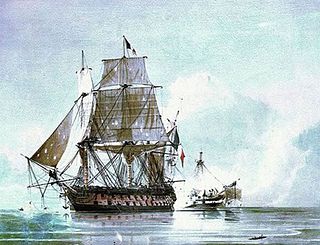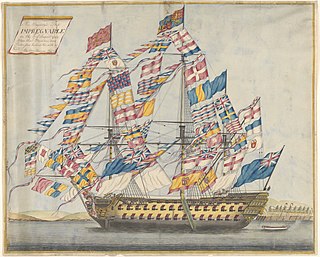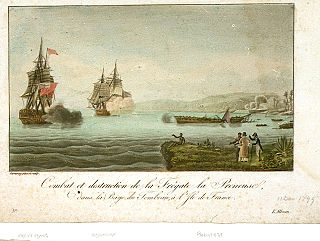
HMS Leander was a Portland-class 50-gun fourth rate of the Royal Navy, launched at Chatham on 1 July 1780. She served on the West Coast of Africa, West Indies, and the Halifax station. During the French Revolutionary Wars she participated in the Battle of the Nile before a French ship captured her. The Russians and Turks recaptured her and returned her to the Royal Navy in 1799. On 23 February 1805, while on the Halifax station, Leander captured the French frigate Ville de Milan and recaptured her prize, HMS Cleopatra. On 25 April 1805, cannon fire from Leander killed an American seaman while Leander was trying to search an American vessel off the US coast for contraband. The resulting "Leander affair" contributed to the worsening of relations between the United States and Great Britain. In 1813, the Admiralty converted Leander to a hospital ship under the name Hygeia. Hygeia was sold in 1817.

HMS Minerva was a 38-gun fifth-rate Royal Navy frigate. The first of four Minerva-class frigates, she was launched on 3 June 1780, and commissioned soon thereafter. In 1798, she was renamed Pallas and employed as a troopship. She was broken up in 1803.

HMS Zebra was a 16-gun Zebra-class sloop of the Royal Navy, launched on 31 August 1780 at Gravesend. She was the second ship to bear the name. After twenty years of service, including involvement in the West Indies campaigns during the French Revolutionary Wars, she was converted into a bomb vessel in 1798. In this capacity she took part in attacks on French ports, and was present at both battles of Copenhagen. The Navy sold her in 1812.

HMS Impregnable was a Royal Navy 98-gun second rate ship of the line launched on 15 April 1786 at Deptford Dockyard. She was wrecked in 1799 off Spithead.
HMS Fly was a Swan-class ship sloop of the Royal Navy, launched on 14 September 1776. She performed mainly convoy escort duties during the French Revolutionary Wars, though she did capture three privateers. She foundered and was lost with all hands early in 1802.

HMS Castor was a 32-gun Amazon-class fifth-rate frigate of the Royal Navy. She served during the French Revolutionary and Napoleonic Wars. The French briefly captured her during the Atlantic Campaign of May 1794 but she spent just 20 days in French hands as a British ship retook her before her prize crew could reach a French port. Castor eventually saw service in many of the theatres of the wars, spending time in the waters off the British Isles, in the Mediterranean and Atlantic, as well as the Caribbean.

HMS Daedalus was a 32-gun fifth rate frigate of the Royal Navy, launched in 1780 from the yards of John Fisher, of Liverpool. She went on to serve in the American War of Independence, as well as the French Revolutionary and Napoleonic Wars.
HMS Advice was a 10-gun cutter that the Royal Navy purchased in 1779. She was wrecked in 1793.

HMS Adamant was a 50-gun Portland-class fourth rate warship of the British Royal Navy. She served during the American War of Independence, the French Revolutionary Wars, and the Napoleonic Wars in a career that spanned thirty years.

HMS Sprightly was a 10-gun cutter of the Royal Navy, built to a design by John Williams, and the name ship of her two-vessel class of cutters. She was launched in 1778. The French captured and scuttled her off the Andulasian coast in 1801.

HMS Greyhound was a cutter that the British Admiralty purchased in 1780 and renamed Viper in 1781. Viper captured several French privateers in the waters around Great Britain, and took part in a notable engagement. She was sold in October 1809.
HMS Eagle was a Dutch hoy that the Admiralty purchased in 1794. She was commissioned into the Royal Navy in March 1794 under Lieutenant David Hamline for the Channel Islands. She and several of her sister ships — — formed part of a short-lived squadron under Philippe d'Auvergne at Jersey in the Channel Islands. Eagle was paid off in 1795 and then lent to the Royal Navy's Transport Board in March 1796.
HMS Resolution was a cutter that the Royal Navy purchased in 1779. She captured two French privateers in 1781 and a Dutch privateer in 1783 after a single ship action. Resolution captured one more small French privateer in June 1797; later that month Resolution went missing in the North Sea, presumed to have foundered.
HMS Ranger was the 14-gun revenue cutter Rose, launched in 1776, that the Royal Navy purchased in 1787, and that the French captured in 1794. The British recaptured her (twice) in 1797 and renamed her HMS Venturer. The Navy sold her in 1803.
HMS Speedwell was a mercantile vessel that the Admiralty purchased in 1780. During the American Revolutionary War she served at Gibraltar during the Great Siege. In 1796 she was converted to a brig. Although she did capture two French privateers and participate in an incident in which the Royal Navy violated Swedish neutrality, her service in the French Revolutionary and Napoleonic Wars was apparently relatively uneventful. A storm in February 1807 destroyed her, causing the loss of her entire crew.
HMS Spider was formerly the French privateer Victoire, built at Dunkirk in 1782, that the Royal Navy captured that same year. The Navy commissioned her as Spider. She served during both the French Revolutionary and early Napoleonic Wars, capturing some five French privateers before being sold at Malta in 1806 for breaking up.
HMS Cockatrice was the fourth of the Alert-class British Royal Navy cutters. She was launched in 1781 and had an uneventful career until the Navy sold her in 1802. Private interests purchased her, lengthened her, and changed her rig to that of a brig. They hired her out to the Navy and she was in service as a hired armed brig from 1806 to 1808. She then returned to mercantile service until she was condemned at Lisbon in May 1816 as not worth repairing.
HMS Pilote was a cutter launched for the French Navy at Dunkirk in 1778. The British Royal Navy captured her in 1779 and took her into service under her existing name. It sold her in 1799.
Lord Mulgrave was launched at Whitby in 1783. She had a mercantile career until 1793 when the Admiralty hired her to serve as an armed ship protecting convoys. She was wrecked in 1799.
The Royal Navy purchased HMS Barracouta on the stocks in 1782. After she had served for almost ten years patrolling against smugglers, the Navy sold her in 1792. She became the privateer Thought, which had a successful cruize, capturing several prizes including a French privateer, but then was herself captured in September 1793. She served the French Navy under the names Pensée, Montagne, Pensée, and Vedette, until the British recaptured her in 1800 and renamed her HMS Vidette. The Royal Navy sold her in 1802.








